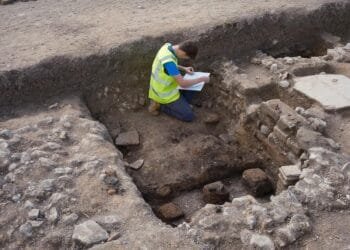For the first time since the 1930s, a 5,000-year-old timber circle that burned down during a Neolithic midwinter solstice has been excavated, BBC News reported.

Arminghall Henge, located just outside Norwich, was discovered by a pilot surveying for ancient monuments in 1929.
According to archaeologist Andy Hutcheson, The blaze would have created “a hell of a bonfire which burnt for days.”
Dr. Hutcheson following the dig they now believe it was deliberately set alight during a winter gathering.
Radiocarbon dating in 2010 suggested that it was constructed between 3525BC and 2700BC.
Eight 1m (3ft) diameter 5.5 tonne (12,124lb) posts were sunk into the ground.
Dr. Hutcheson of the Sainsbury Institute at the University of East Anglia said: “They were at least 10m (32ft) above ground, so the circle would have been pretty impressive.
“A huge amount of people would have been needed to bring the timbers to the site and put them in place.
“It was also sited to take advantage of the setting sun on the midwinter solstice, like Stonehenge.”
Arminghall Henge was constructed on land above a valley where three rivers meet.
Dr. Hutcheson believes it was deliberately placed on raised ground so it could be seen and near a river confluence for ease of access.
“Another new thing we’ve found is there was more of an escarpment in the past, so from the river valley the henge would have looked much more spectacular,” he said.
The 12m (39ft) timber circle was surrounded by a later 76m (249ft) diameter earthwork henge.

During the excavation, which was helped by volunteers from the mental health and heritage charity The Restoration Trust, charcoal was found in the post holes and the lower layers of the inner earthwork ditch.
Dr. Hutcheson believes the timber circle was deliberately burnt and its remains added to the earthwork monument.
“Archaeologists now think that this sort of thing was seasonal and therefore to do with the solstice,” he added.
“It would have been a hell of a bonfire which burnt for days.” — BBC News





























